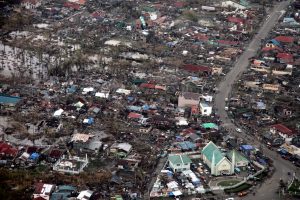The world’s strongest storm this year killed at least 19 people and cut power to an island of 260,000 when it made landfall in the Philippines on November 1, leaving the country scrambling to mobilize a relief effort.
Super Typhoon Goni, known in the Philippines as Rolly, struck the island of Catanduanes and nearby Albay province as it tore a path across the country, avoiding the capital region of Manila but destroying tens of thousands of homes and leaving over 125 cities and towns without electricity.
The typhoon caused over $280 million in infrastructure damage, the country’s public works secretary said Thursday.
The storm hit the Philippines as it continues to combat one of the region’s worst coronavirus outbreaks. Some communities were deprived of information after ABS-CBN, the nation’s leading broadcaster, was ordered off the air in May in what critics called an attack on press freedom. The network had been the only free station to reach millions in rural areas and to broadcast in regional languages.
The Philippines may have avoided a higher death toll due to increased awareness and preparation after 2013’s devastating Typhoon Haiyan, which killed more than 6,300 people. The country is regularly hit by typhoons, earthquakes, tsunamis, floods and volcanic eruptions and is among the world’s most vulnerable to the effects of climate change.
Hundreds of thousands remain in evacuation centers, where officials are urging them to practice social distancing and sanitation measures due to the coronavirus pandemic.
President Rodrigo Duterte was harshly criticized for spending the weekend out of the public eye at his home in Davao City, on the southern island of Mindanao. Cabinet secretaries oversaw high level government briefings on the typhoon response in Duterte’s absence.
The president traveled to Albay province on Monday, where he said he had been “waiting for the typhoon to pass” as he paid respect to the dead for All Souls’ Day. “To those who say that I’m not here, what’s the problem?” Duterte said.
In a late night briefing on November 5, Duterte sent more vitriol toward critics of his public absence as the typhoon struck, sarcastically urging them to kill their relatives so that they can visit their graves for All Souls’ Day.
Earlier in the week, opposition senators criticized the government’s storm response, urging that relief funds be taken from the expanded budget of the anti-communist task force, which has been scrutinized this week in Senate hearings after one general falsely branded several celebrities as communist sympathizers.
“It is clear that the billions [of Philippine pesos] earmarked for the [task force] would be better spent on helping Filipinos battered by the typhoon get back on their feet,” said Sen. Risa Hontiveros, a frequent Duterte critic.
Part of that process will entail restoring power to Catanduanes, which lost contact with the rest of the Philippines as the storm hit.
The Philippine energy department said on November 4 that it hopes to restore 100 percent of the island’s power by Christmas. An energy official said around 500 workers have been dispatched to the Bicol region, where Catanduanes is located, and that the island’s largest city could have power restored within one to two weeks.
The Red Cross has said Tuesday it could take months to fully restore the power supply to Catanduanes after one official took a flying visit to the island.
Major roads on the island remain impassable, although the public works secretary said they should be cleared in the next few days.
The European Union on November 4 announced 1.3 million euros in aid for emergency relief assistance to be delivered to families affected by the storm.
The relief effort also got a major assist from one powerful force: the BTS Army. K-pop fans launched donation drives to NGOs aiding in the relief efforts, including one raising funds for Save the Children Philippines.

































